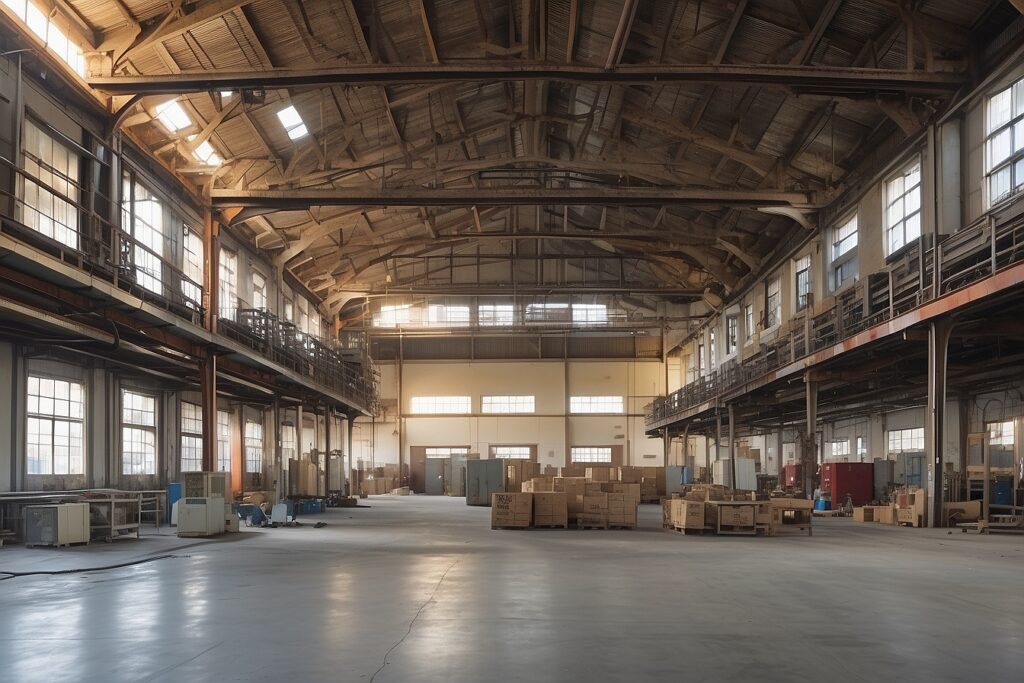Unprecedented Growth in Industrial Construction in the Czech Republic

The construction of new industrial space in the Czech Republic surged to unprecedented levels last year, marking a significant milestone in the country’s real estate landscape. A staggering total of nearly 1 million square meters of industrial space was added, representing a remarkable 22 percent increase compared to the five-year average. The bulk of this construction activity was concentrated in the Karlovy Vary region, contributing substantially to the country’s overall industrial inventory, which soared to 11.7 million square meters.
Despite the robust expansion of industrial infrastructure, demand witnessed a notable weakening trend throughout the year. As a result, the vacancy rate experienced a marked increase, rising by 94 basis points year-on-year to reach 1.74 percent. This translates to approximately 205,500 square meters of immediately available industrial or warehouse space across the country. These shifts in supply and demand dynamics reflect the evolving landscape of the industrial sector in the Czech Republic.
In tandem with these developments, the highest achievable rent, commonly referred to as the “prime rent,” experienced a slight decline at the onset of the year. However, it stabilized thereafter, settling in the range of €7.50-7.70 per square meter per month for the remainder of 2023. These insights are gleaned from a comprehensive survey conducted by Colliers, shedding light on key trends shaping the industrial real estate market in the Czech Republic.
The surge in industrial construction underscores the growing importance of the sector as a cornerstone of the Czech economy. As demand for industrial and warehouse facilities continues to evolve, stakeholders must remain attuned to shifting market dynamics, balancing supply-side expansion with demand-side considerations. Moreover, the increase in vacancy rates highlights the need for strategic asset management and tenant engagement strategies to optimize occupancy levels and maximize asset value.
Looking ahead, the industrial real estate market in the Czech Republic is poised for further evolution, driven by technological advancements, changes in consumer behavior, and broader economic trends. As the country positions itself as a key player in the regional industrial landscape, stakeholders must leverage market insights and innovative solutions to navigate challenges and capitalize on emerging opportunities. Through proactive collaboration and strategic decision-making, the Czech Republic can cement its position as a leading destination for industrial investment and development in Central Europe.
Completion of Industrial Projects Fell Short of Expectations in 2023
Despite the addition of a substantial 921,300 square meters of modern industrial space throughout 2023, the final outcome fell short of initial projections. Although this volume surpassed the five-year average by 22 percent and the ten-year average by 48 percent, the market had anticipated surpassing the 12 million square meter mark by the year’s end. As of December 2023, there were 1,348,300 square meters of space under construction, marking a modest 4 percent year-on-year increase.
Notably, the majority of construction activity was concentrated in the Karlovy Vary region, accounting for 30 percent of total construction, followed by the Pilsen region at 15 percent, and Prague and the Central Bohemia region each contributing 15 percent. However, it is worth highlighting that for the majority of 2023, there were no ongoing construction projects within the administrative boundaries of Prague, the Czech capital. Instead, development efforts were concentrated to the north and northwest of the city, particularly around the D8, D5, and D6 motorways.
Josefina Kurfürstová, an analyst at Colliers, sheds light on this trend, emphasizing the ongoing reliance on outlying areas to serve the logistical needs of Prague. She notes that this pattern is likely to persist until infrastructure development in the southern and eastern regions of the city is addressed. Once these transportation challenges are resolved, it is anticipated that industrial development will spread to the surrounding regions, driving further growth in regional industrial property markets.
Looking ahead, the industrial real estate sector in the Czech Republic remains poised for continued expansion, albeit with a shifting geographical focus. As infrastructure improvements and urban development initiatives gain traction, opportunities for industrial growth are expected to proliferate across diverse regions. By aligning development efforts with evolving market demands and addressing infrastructure bottlenecks, stakeholders can unlock the full potential of the Czech industrial landscape, driving sustained economic growth and prosperity.
Vacancy Rate Maintains Below 2 Percent Threshold
The vacancy rate in the industrial and warehouse sector experienced a notable uptick, rising by 94 basis points year-on-year to reach 1.74 percent. This increment translates to approximately 205,500 square meters of available industrial or warehouse space. While this increase reflects a shift in market dynamics, it remains relatively low compared to some neighboring markets, such as Poland.
In contrast to Poland, where new and speculative construction has surged in recent years, resulting in a sharper increase in vacancy rates, the Czech Republic has witnessed a more moderate trajectory. For instance, in the third quarter of 2023, the vacancy rate for the Polish market surged by 358 basis points year-on-year to 7.71 percent. However, unlike the Czech Republic, this newly constructed space in Poland is readily available for occupancy upon completion.
Josefina Kurfürstová notes that in the Czech market, despite the presence of several large projects, there exists a growing volume of unfinished space. These spaces have been constructed but require additional work, typically spanning 3 to 6 months, before they become operational and suitable for tenant occupation. While the current vacancy rate stands at 1.74 percent, the influx of these unfinished spaces, if swiftly completed on a speculative basis, has the potential to elevate the vacancy rate above 4 percent.
The phenomenon of unfinished spaces underscores the nuances of the Czech industrial and warehouse market, where construction activity often outpaces the pace of occupancy. As developers race to bring new projects to fruition, it is essential to balance supply-side expansion with demand-side realities. Proactive measures, such as strategic planning and tenant engagement initiatives, can help mitigate the risk of escalating vacancy rates and ensure optimal utilization of industrial and warehouse assets.
Looking ahead, stakeholders in the Czech industrial real estate sector must remain vigilant, monitoring market trends and adapting strategies to navigate potential challenges effectively. By fostering collaboration and fostering a dynamic ecosystem of industry players, the Czech Republic can sustain its position as a prime destination for industrial investment and development in the region.
Cooling Demand Trends in 2023
Throughout 2023, the market witnessed a notable deceleration in demand, as many industry players grappled with shifting macroeconomic conditions. Gross demand for the year totaled 1,520,600 square meters, marking a significant 31 percent year-on-year decline and an 18 percent downturn compared to the five-year average.
Meanwhile, net realized demand amounted to 927,900 square meters, representing a 27 percent decrease year-on-year. Notably, pre-lets emerged as the dominant transaction type, comprising 41 percent of total transactions, closely followed by renegotiations at 38 percent.
Despite the overall downturn, the market’s performance in 2023 mirrored that of 2019, albeit with larger quarterly fluctuations. The second quarter saw the highest quarterly take-up, exceeding 550,000 square meters, while the third quarter recorded the lowest quarterly take-up, falling short of 200,000 square meters.
In terms of gross demand, tenants in the logistics and transportation sector emerged as the primary lessees in 2023, accounting for 35 percent of total space leased, closely trailed by manufacturing companies at 33 percent. Within the manufacturing sector, automotive and electronics manufacturers demonstrated particularly robust demand, underlining their resilience amidst challenging market conditions.
Rent Stability Amid Market Fluctuations
The prime rent, representing the highest achievable rental rate, experienced a marginal decline of 3 percent at the onset of the year before stabilizing within the range of €7.50-7.70 per square meter per month for the remainder of 2023. Although this marks a slight decrease from the beginning of 2021, it still reflects a significant increase of over 50 percent compared to two years prior and even more pronounced growth over the past five years.
This trajectory stands in stark contrast to rental trends observed in major city markets across Germany, where prime rents have surged by approximately 20 percent since 2021. The robust growth witnessed in the Czech market underscores its resilience and attractiveness to investors.
Regions outside the capital have experienced slightly slower but more consistent growth, with rents in prime areas ranging from €5.70 to €6.60 per square meter per month. Mezzanine office space commands higher rental rates, typically falling within the range of €9.50 to €12.50 per square meter per month. Additionally, service charges typically range from €0.75 to €1.00 per square meter per month, reflecting additional costs associated with property management and maintenance.
Opportunities Arising from Nearshoring
The ongoing supply chain disruptions, particularly those arising from trade route disturbances across the Red Sea, have prompted some clients to reconsider their manufacturing and warehousing strategies, leading to renewed interest in nearshoring initiatives. Nearshoring involves diversifying operations to more secure locations in neighbouring regions, thereby mitigating risks associated with global supply chain vulnerabilities. In this context, the Czech Republic emerges as a promising destination, offering a compelling combination of strategic advantages.
Despite being positioned at a higher cost level relative to certain competitors, the Czech Republic boasts a prime geographical location that facilitates efficient access to the broader Central European market. This strategic advantage is particularly valued by tenants seeking to optimize their supply chain networks and service a diverse customer base across the region. Furthermore, the country is renowned for its highly educated workforce and robust economic infrastructure, making it an ideal hub for complex services and product offerings.
In conclusion, while the Czech real estate market demonstrates stability in rental rates amidst global economic uncertainties, the emergence of nearshoring opportunities presents new avenues for growth and investment. By leveraging its strategic advantages and fostering a conducive business environment, the Czech Republic stands poised to capitalize on shifting market dynamics and emerge as a preferred destination for industrial and warehousing operations in the region.



